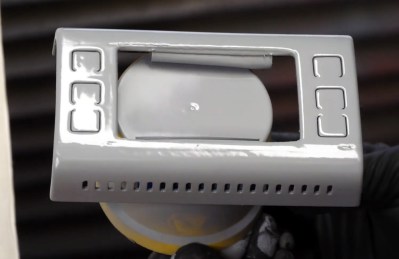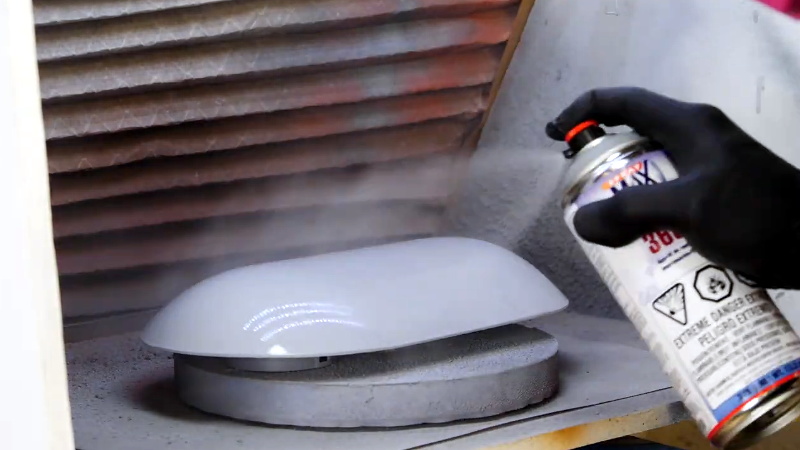When putting together a home workshop, available floor space is often the deciding factor when it comes time to pick tools and equipment. This ultimately leads to some very difficult decisions, and we’d wager there isn’t a hacker or maker reading this that hasn’t had to pass on a new piece of gear because they didn’t have anywhere to put it.
For example, the average home gamer isn’t going to have a paint booth and spraying equipment, so they have to settle for a rattle can in the backyard. Traditionally this has limited the kinds of products you can realistically apply, but as [Eric Strebel] shows off in his latest video, it seems like spray can technology is starting to catch up.

Specifically, he’s been working with a canned two-part primer that doesn’t require any complicated mixing or special equipment to apply. After hitting a plunger on the bottom, a small compartment containing the activator is ruptured and the reaction begins. From that point, you’ve only got 24 hours to use the contents of the can before it cures. But since you only need to wait about 10 minutes between coats, that should give you plenty of time to complete the project.
In the video, [Eric] demonstrates how quickly this high-build primer can smooth out the layer lines on a 3D print. While you’ll still need to sand and potentially break out the spot filler to achieve that perfect finish, it’s clear that the primer works much better than anything we’re used to seeing come out of a can. Even after just two coats, the results are truly remarkable.
If there’s a downside, it’s that a can of this primer will run you about $25 USD. That’s about five times the cost of the Rust-Oleum Filler Primer that usually gets recommended in DIY circles, but the results really do seem to speak for themselves. We wouldn’t necessarily use this on every project, but if you’ve got something that needs an especially fine finish, you’ve at least got an option that doesn’t involve borrowing somebody’s compressor and spray gun.
If you need help shaking your paint before spraying – definitely give this 3D printed paint shaker a look!















There is also the Maston 2K series of two-component sprays. Instead of having the two components separate, it has a chemical inhibitor that stops inhibiting (evaporates? oxidizes?) when the spray hits air, allowing the reaction to begin. This means that the paint can be stored much longer than 24 hours.
Though in my experience, it hardens quite slowly compared to traditional 2-component paints. When I applied a thick coat of lacquer in thin layers, the tackiness disappeared in an hour but the surface was noticeably soft for a week.
I wonder if there is a place for something like a UV cured spray paint primer. Even dunking in uv resin or thinned uv cure nail varnish (followed by curing) might be a good way to get the surface ready for a finish coat. Maybe such techniques are already widely used and I’ve just not heard of it.
No need for an aerosol, a regular disposable brush works pretty well for applying UV resin.
I think he meant a primer that was UV curable, which I’m also interested in.
yeah this is just what i was thinking…now that i know it’s possible to get a fast-set spray paint, i feel like there ought to be a more convenient way, something to quick-set traditional spray paint. has anyone tried uv on rusto? :)
They are available. They’re primarily sold for vehicle use.
The small parts he’s painting, a air brush and mixing your own two part primer would be much better. A good 3/4 of that can is just going to the landfill.
The whole point is that this is ideal for people who don’t have an air brush, or don’t want to mix a 2-part for perhaps the first/only time in their life. Seems odd I’d even have to explain this, but he’s also painting small parts because this is a demonstration video for YouTube. Obviously you wouldn’t buy this whole ~$30 can to do one part that small.
I wonder if you even read the post, or are just commenting on the pictures. Actually not wondering, pretty sure I know the answer.
agree with what you said, Ergotron, but for my uses, i would exactly buy this whole $30 can for one part this small. or, i wouldn’t, but gee sometimes i wish i would. almost all my projects are of the size where i use a tiny fraction of a can but still would appreciate better material qualities…for example, i’m already used to throwing out 90% of the epoxy i ever mix.
I always try to have a little backlog of stuff to stick or cast with epoxies so when mixing you can use much of that extra you annoyingly had to have to actually get a proper mix for the high priority project you are doing – which means I actually tend to mix reasonable sized batches and waste less than 10%.
You are quite correct though there are times you just have to use a little of something, knowing large amounts of it will go to waste…
Also I’d not really want to fire a 2 part through my little airbrush either, those are a pain to clean of any ‘dried’ paint/varnish type stuff when its water washable! Probably would use it through the bigger one, but then again you are wasting huge volumes as overspray and to fill the feed enough to actually feed if using it on the tiny parts…
Kinda implies that there’s market for this system in those half or third-height cans they sell wash-out costume hair colors in.
Those were sold for R/C painting by Tamaya(?) back in the day at hobby shops. So the form for spray paint in general wouldn’t be new.
Read what I wrote Ergotron …..”The small parts ****he’s**** painting….”
You can add as many stars as you want, it still doesn’t make any sense.
He’s using this spray in the video as a demonstration for the video. He has a full workshop and doesn’t NEED to use a can, it’s being done for the benefit of the viewer.
Would you rather he had just sit there facing the camera talking about it, instead of showing how it worked?
Well, I read it and I have to agree. This is dumb for the application. $25 for a can. Results be damned. Airbrush sets are cheap, and bigger gravity fed paint guns can be had for the cost of a single can of this stuff. Nobody said anything about requiring a fancy paint booth. A simple carboard box with the part staged inside will suffice. It isn’t hard to learn how to paint…after all we are all here learning how to do all this stuff. What’s one more skill? but I guess it’s easier to dump partially cured cans of two part spray cans in a landfill. C’mon guys, this is a solution looking for a problem.
This is honestly an incredibly ignorant and really privileged comment.
So a person who might only need to do a 2K primer once or twice in their life is supposed to go out and buy a air brush and compressor? Why spend $25 when you could spend 4x that, right?
And where are they supposed to store it? There’s been people at my hackerspace that have, for various reasons, had to live in their cars or motel rooms for stretches of time. Are those individuals not allowed to use paint either in your utopian vision of the world?
As I recall, one of the Hackaday writers recent spent some time without a home and even wrote a couple articles about keeping equipment down to the absolute bare minimum. Don’t remember much mention of compressors in that post, though I suppose the cardboard box would be easy enough to source.
Consider yourself lucky that your life has been so blessed that you don’t even realize how clueless and jaded you sound when you spout this nonsense.
I wonder if mixing two-part primer would work well with a bring-your-own-liquid spraying system like Preval.
Lucky my friend works at a automotive paint supply store. He puts all sorts of weird stuff into cans for me. Good paint makes the world of difference.
Oh, oh, can he get me a can of this!?
https://aweapps.com/images/easyblog_articles/118/b2ap3_thumbnail_3b8299e5acf5d4a54ee7bb928bf49561.jpg
…and if you need help shaking your paint before spraying, and don’t have a 3d printer:
https://youtu.be/VWJ5qdCe8sY
ALSA has had this in clear for years. You just need a lot to paint at once to avoid all the waste.
Yep I used one of these 2 part clears (with the extra button on the bottom) to clear a spoiler, has held up just as good as if I had set up my spray gun and used proper 2part clear. Was super handy and convenient, didn’t know companies were coming out with other products. Brilliant for the diy-er. And arguably the professional too if doing a small repair, time saved cleaning and filling the gun is likely offset by these style aerosols.
That’s what I was thinking, I saw someone using this on a computer case and thought “holy crap I need some of THAT” then I saw the price and the fact its single use turned me away from it forever. Its a great idea if you can lay down a perfect primer coat on all your parts all at once otherwise “for the home gamer” its pointless. Which is why you probably don’t hear about its use much
Cheaper for small volume areas where you want an epoxy-sealed surface, but not as nice a finish, is the original JBWeld: mixed, then diluted with lacquer thinner to a viscoscity suitable for brushing. I tried with acetone, but it evaporates away too quickly, so you’re trying to brush on with a changing viscoscity, if you’d like to be frustrated.
Leaves a good but variable thickness surface (some self-leveling, but only from point to point, not across the whole surface). Can be sanded smooth to shape. Very tolerant of re-brushing while still wet; dip brush in mix or a dish of lacquer thinner as required. Makes for very rust resistant brake calipers, brackets, etc..
The Spraymax line of cans is superb. Apart from the filler primer they also have regular “epoxy” primer, clear coats (gloss, satin, matte and a range of colors. Only thing is these are significantly more toxic than the plain stuff. One should use a proper respirator, with a filter rated for organic vapors, along with eye protection.
Do you really want to give people working with rattle cans in the back yard the ability to do a professional looking job?
Invent a paint that has a smell while drying that repels gnats!
So many almost perfect paint jobs… except for the spot where that damn bug flew into it!
Tweezers
Remove the gnat carefully before the paint sets.
I wonder if he got the idea from a bottle of Guinness with the “widget”. 25 year old technology…
Just keep in mind that these catalyzed two part paints are most often hardened with iso-cyanates.
The warning labels on these self mixing 2k paints aren’t the greatest, but you really don’t want to be breathing CNS inhibitor chemicals.
If you want to work with hardened paints, take the time to search, and either find cyanate-free paints, or mix your own and use self filled spray cans or a spray gun.
If you look around, you can find cyanate free hardeners, though they aren’t as easily found as the more common iso-cyanate hardeners.
https://multimedia.3m.com/mws/media/777847O/isocyanates-3m-techupdate.pdf
https://www.onestopaerosols.co.uk/1k-2k-paint-information/
https://autobodystore.com/forum/showthread.php?8682-Respirator-for-isocyanate
https://www.hse.gov.uk/mvr/bodyshop/isocyanates.htm